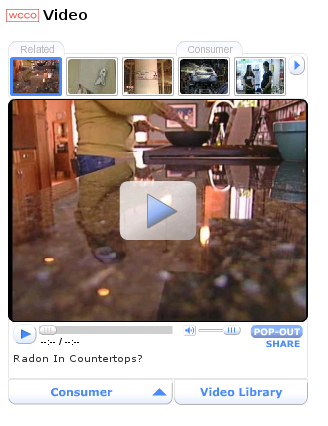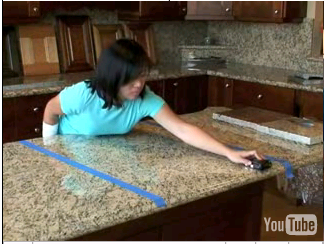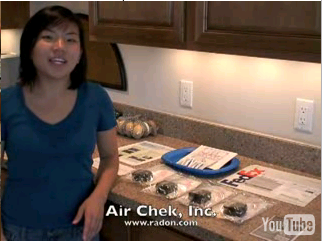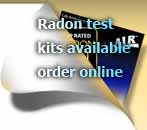
Granite and Radon
Recent media attention has focused on granite countertops and whether they can increase your indoor radon levels. While testing your home is always a good idea, a few clarifications are in order.
|
|
FACT - All natural products, especially stone, minerals, and sand, contain trace amounts of some radioactive elements called NORMs (Naturally Occurring Radioactive Mineral) that can produce measurable amounts of radiation and sometimes radon gas.
This includes all concrete products, clay bricks, most non-plastic plates and dishes, coal and the flyash produced in coal-fired power plants, natural gas (contains radon), phosphate fertilizers used in your garden (ALL contain potassium and small amounts of uranium and thorium), and the vegetables grown using those fertilizers. The Border Patrol often catches truck loads of marijuana because it is loaded with radiation producing potassium), all glass made using silica (even eye glasses, wine glasses, mirrors, windows, etc.), and granite too. There are thousands of items we could list. If interested, visit these links for more info:
However, the key word is "measurable". As an illustration, compare the radon produced by your naturally-occurring stone surfaces, such as granite, to the heat produced by a birthday candle. Although you wouldn't be able to heat your entire kitchen using a birthday candle you can easily feel the heat if you put your hand over it. This is similar to placing a geiger counter over a tiny speck of uranium, thorium, radium, or potassium. The detector will make thousands of clicks per minute but be of little concern. If your stone surface emits a small amount of radon, as happens in most cases, it will generally be insignificant when diluted with the quantity of air in your entire home.
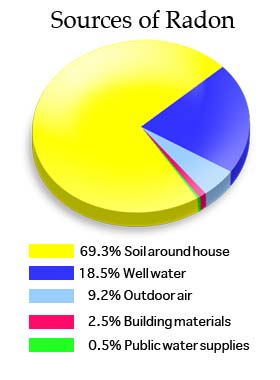 You are hundreds of times more likely to be at risk for radon emanating from the soil beneath your home.
The US EPA states it simply in the Consumer's Guide to Radon Reduction:
You are hundreds of times more likely to be at risk for radon emanating from the soil beneath your home.
The US EPA states it simply in the Consumer's Guide to Radon Reduction:
"In a small number of homes, the building materials (e.g., granite and certain concrete products) can give off radon, although building materials rarely cause radon problems by themselves. In the United States, radon gas in soils is the principal source of elevated radon levels in homes."
I still want to test my granite surface. What should I do?
You can order an activated charcoal Complete Granite Surface Test Package on our online store.
Recently, many radon labs reported that consumers are placing their radon-in-air test devices on granite surfaces under bowls, buckets, baking pans, or other similar containers. BEWARE of suggestions to place an ordinary radon test kit under an inverted container of an unknown volume. Such an experiment will, 99% of the time, grossly over-report the radon levels. Using this method to determine the radon that may be coming from your granite will be inaccurate and will likely result in a number that is very high.
Why? Because only a charcoal device that has been calibrated to measure true "radon emanation" captured in a known volume for a precise amount of time can provide valid information.
It's important to use a test where the laboratory knows the EXACT exposure volume, test multiple locations on the granite surface due to possible "hot spots", and to simultaneously perform additional tests in the area of the granite surface and in another area at least 20 feet away. If your indoor radon levels in both areas are substantially similar, the granite likely does not have a measurable effect on your indoor radon-in-air levels. If the levels of radon in the area containing the granite are higher than your indoor levels in another area of your home AND the surface top test devices also return high results, then it is possible that the granite is contributing to, or is the source of, your indoor radon levels.
Why Geiger Counters will not accurately measure radon
Most web videos and TV demonstrations measure the granite counter top using a Geiger Counter. These simple audible devices are being used for dramatic effect and are misleading in two principle ways:
1. Simple hand-held Geiger Counters are not calibrated for measuring ONLY the radon-producing Radium in granite. This means they will almost always over-respond when attempting to measure the radon emissions.
2. Not all the radiation coming from the granite that makes the clicking sound comes from radon-producing Radium. In most cases the noise is produced by two other naturally occurring elements: Potassium and Thorium. In fact, up to 95% of the Geiger Counter clicks may come from the Potassium. Potassium is very common and is found in our own bodies, as well as many foods and vitamin supplements.
FACT: Testing has shown that a "pancake" detector equipped Geiger Counter (like those used on TV for dramatic effect) will over-respond 10 to 20 times more than a professional grade radiation detector like those used in hospitals and nuclear power plants.
FACT: Potassium does not produce any radon gas.
Thorium produces a different type of gas called Thoron. Thorium is a shorter-lived element, which is similar to radon but decays about 6,500 times faster than radon. Thoron has a half-life of about 51 seconds, whereas Radon has a half-life of just over 92 hours. Because most of the Thoron never makes it very far from the granite's surface, the US EPA does not consider Thoron a major contributor to health problems.
The bottom line. Gamma measurements made with simple hand-held meters alone CANNOT tell you how much radon is being produced by your natural stone materials. These simple meters grossly over-respond to the actual radiation coming from the stone surface. Gamma measurements can only be used to find "hot-spots" that may be emitting radon. These "hot-spots" can then be tested using calibrated activated charcoal devices. Results, or emanation rates, from the surface tests are reported as "volume-per-surface-area-per-time" of radon gas. See our gamma meter that can be used in tandem with a surface test to be performed in a provided container of known volume. Test reports for radon emanation tests (i.e., radon canisters placed under a mixing bowl) cannot be reported in pCi/L because they are not accounting for the surface area or the time factor that are necessary for radon emanation or radon flux rates. The Air Chek surface tests are collected for a specific amount of time (i.e., 48-72 hours) in a known volume, over a known surface area, and can be properly analyzed and calculated with sophisticated laboratory equipment. This is not the only method for measuring the amount of radon coming from the granite, but it is the most economical.
* - The US EPA recommends taking corrective measures for radon levels at or above 4 pCi/L
* - The US EPA encourages you to consider reducing your radon levels for readings between 2 and 4
You can order a Complete Granite Counter Top Test using using our secure online store.
